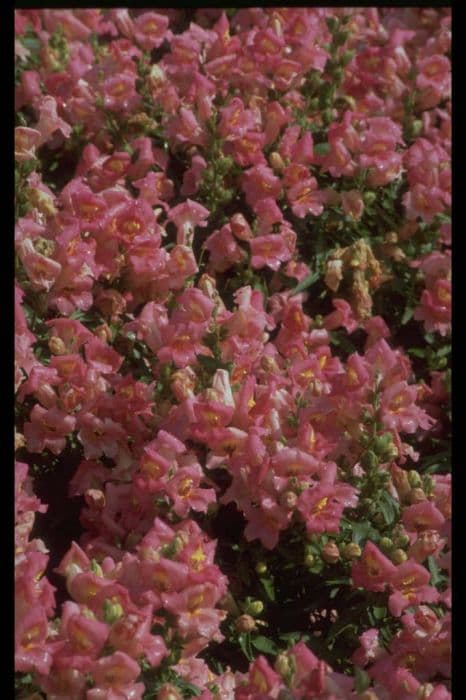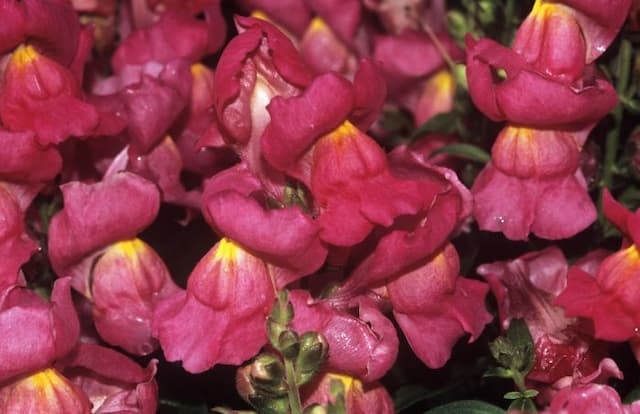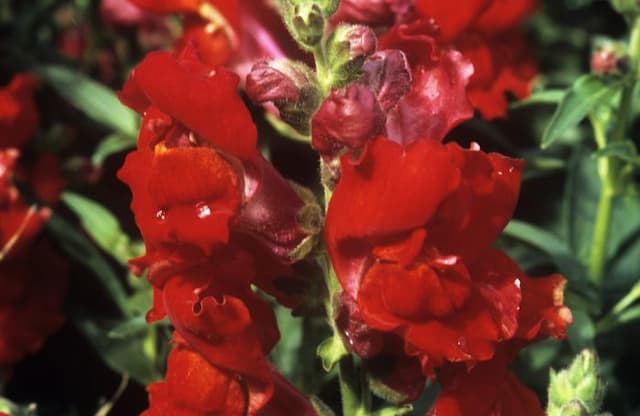Beardtongue Penstemon 'Beech Park'

ABOUT
Penstemon 'Beech Park' is a striking perennial plant known for its vibrant and showy flowers. This particular cultivar typically boasts a plentiful array of tubular blooms, which are most commonly found in a rich shade of purple or violet, sometimes with a gradient that fades to a lighter hue near the throat of the flower. The blossoms are densely clustered on tall, upright stalks, creating a visual spectacle that resembles spikes or wands, which can be particularly attractive to bees, butterflies, and hummingbirds. The foliage of the 'Beech Park' penstemon complements its floral display with lush, green leaves that exhibit a lanceolate or elongated shape, with a somewhat glossy texture and a fine-toothed margin. These leaves are often arranged in pairs along the stem, providing a lush and full appearance to the plant. The foliage can sometimes take on a reddish tint, especially under certain growing conditions or during the cooler months, adding to the plant's ornamental appeal. Overall, Penstemon 'Beech Park' exudes a rustic yet refined charm, making it a favorite in garden landscapes for its ability to inject color and vertical interest. Its appealing form, combined with its capacity to attract pollinators, renders it an excellent choice for planting in borders, flower beds, or as part of a pollinator-friendly garden.
About this plant
 Names
NamesFamily
Plantaginaceae
Synonyms
Beardtongue, Penstemon
Common names
Penstemon 'Beech Park'
 Toxicity
ToxicityTo humans
Penstemon, also known as beardtongue, is generally considered non-toxic to humans. There are no significant toxic effects reported for Penstemon 'Beech Park' if ingested by humans. However, as with any plant material, individual allergies or sensitivities could potentially cause mild stomach upset or dermatological reactions in some people.
To pets
Penstemon, also known as beardtongue, is generally considered non-toxic to pets. There are no significant toxic effects reported for Penstemon 'Beech Park' if ingested by pets such as dogs and cats. Each animal may react differently, but toxicity is not typically associated with this plant.
 Characteristics
CharacteristicsLife cycle
Perennials
Foliage type
Deciduous
Color of leaves
Green
Flower color
Mixed
Height
2-3 feet (60-90 cm)
Spread
1-2 feet (30-60 cm)
Plant type
Herb
Hardiness zones
3-8
Native area
North America
Benefits
 General Benefits
General Benefits- Attracts Pollinators: Penstemon, commonly known as Beardtongue, encourages bees, butterflies, and other beneficial insects to visit the garden, aiding in pollination.
- Drought Tolerance: Beardtongue is known for its ability to withstand dry conditions, making it suitable for water-wise gardens and xeriscaping.
- Aesthetic Appeal: The striking flowers of Beardtongue add visual interest and beauty to garden beds, borders, and containers.
- Low Maintenance: Beardtongue requires minimal upkeep, which makes it ideal for gardeners looking for low-maintenance landscaping options.
- Cold Hardy: Capable of withstanding cooler temperatures, Beardtongue is suitable for a variety of climates and can survive through winters in many regions.
- Deer Resistance: Beardtongue is often resistant to deer, reducing the likelihood of damage from wildlife browsing in the garden.
- Long Blooming: Beardtongue has a relatively long flowering period, providing color and vibrancy in the garden throughout the growing season.
- Versatility: Beardtongue can be grown in a range of soil types, from sandy to loamy to clay, as long as there is good drainage.
 Medical Properties
Medical PropertiesThis plant is not used for medical purposes.
 Air-purifying Qualities
Air-purifying QualitiesThis plant is not specifically known for air purifying qualities.
 Other Uses
Other Uses- Artistic Inspiration: The vibrant colors and unique shapes of the Penstemon can serve as a muse for artists and photographers looking to capture the beauty of nature.
- Dye Production: The flowers of the Penstemon may be used to create natural dyes for textiles, giving fabrics a soft, subtle hue.
- Educational Tool: Gardeners and educators can use the Penstemon to teach about pollination, plant biology, and horticulture practices.
- Floral Crafts: The blooms of the Penstemon can be used in dried flower arrangements or potpourri due to their color and form.
- Culinary Garnish: Although not commonly consumed, the flowers can be used as an ornamental garnish for salads and desserts.
- Ecological Indicator: The presence of a thriving Penstemon plant can signal a healthy ecosystem, assisting ecologists in their studies.
- Ink Ingredient: The flower's pigments may be experimented with in the creation of inks for writing and drawing.
- Plant Combinations: Penstemon can be planted alongside other species to create interesting and beneficial plant companionships in gardens.
- Winter Interest: When left unpruned in the fall, the dried stalks and seed heads can add texture and interest to the winter garden landscape.
- Photography Contests: Specialty plants like Penstemon can be the subject of photography contests, especially in horticultural societies or enthusiast groups.
Interesting Facts
 Feng Shui
Feng ShuiThe plant Penstemon is not used in Feng Shui practice.
 Zodiac Sign Compitability
Zodiac Sign CompitabilityThe plant Penstemon is not used in astrology practice.
 Plant Symbolism
Plant Symbolism- Attraction and Charm: The Penstemon, also known as Beardtongue, with its tubular flowers, is a magnet for bees and hummingbirds, symbolizing an attraction that is both natural and effortless. Its beauty and vibrant colors are associated with charm and a capacity to enthrall.
- Resilience and Endurance: Adapted to various climates and conditions, Penstemon represents resilience. It flourishes in rocky and challenging environments, symbolizing the ability to endure difficult situations and to overcome adversity.
- Diversity and Adaptability: With numerous species and hybrids like 'Beech Park', Penstemon exemplifies diversity and adaptability. It suggests embracing variety and adjusting to change, reminding us of the diversity of life and the importance of being adaptable.
- Health and Vitality: The robust nature of Penstemon and its significance in natural medicine, where some species were used by Native Americans for their healing properties, lends it to be a symbol of health and vitality.
- Open Communication: The open flower shape of Penstemon can be seen as a representation of open communication and the sharing of thoughts and emotions, encouraging transparent dialogue and expression.
- Boldness and Courage: The striking appearance of Penstemon blooms, standing tall and bold, is often associated with courage and the willingness to stand out in the crowd.
 Water
WaterThe Beardtongue prefers consistent moisture, so it's best to water it once a week with about one inch of water per square foot, which is roughly 0.62 gallons per square foot. During the growing season, especially in dryer climates, you may need to water it twice a week. Ensure that the water penetrates deeply into the soil to encourage deep root growth. During the winter or in cooler climates, reduce the watering frequency as the plant requires less moisture. However, avoid overwatering to prevent root rot.
 Light
LightThe Beardtongue thrives in full sun to partial shade. It does best with at least six to eight hours of direct sunlight each day. If you're planting indoors, place it by a south-facing window where it can get abundant light. In regions with extremely hot summers, afternoon shade can help to prevent scorching of the leaves.
 Temperature
TemperatureThe Beardtongue can endure a wide range of temperatures, from as cold as 20°F to as warm as 90°F. For optimal growth, the ideal temperature is between 55°F and 85°F. It is hardy and can survive slight drops below freezing but should be protected from prolonged exposure to extreme cold.
 Pruning
PruningPruning the Beardtongue is essential for maintaining its shape and encouraging more blooms. Prune in early spring to remove any dead or damaged stems and promote new growth. Additionally, deadheading spent blooms throughout the blooming season can foster a more prolonged flowering period. A more extensive pruning should be done after the flowering season to prepare the plant for winter.
 Cleaning
CleaningAs needed
 Soil
SoilThe Beardtongue requires well-draining soil with a gritty or sandy composition. The best soil mix includes equal parts of garden soil, sand, and compost to ensure proper drainage and fertility. The ideal soil pH for Beardtongue is slightly acidic to neutral, around 5.8 to 7.
 Repotting
RepottingBeardtongue plants generally do not require frequent repotting and can thrive in the same pot for several years. It's best to repot them every 3-4 years or when the plant outgrows its current container.
 Humidity & Misting
Humidity & MistingBeardtongue plants prefer moderate humidity levels but are quite adaptable and can tolerate the ambient humidity found in most home environments without needing any special adjustments.
 Suitable locations
Suitable locationsIndoor
Provide bright indirect light, well-draining soil, and moderate watering.
Outdoor
Plant in full sun to partial shade, in well-drained soil, protect from harsh winds.
Hardiness zone
4-9 USDA
 Life cycle
Life cyclePenstemon 'Beech Park', commonly known as 'Beech Park Beardtongue', begins its life as a seed which requires stratification, or a period of cold treatment, to break dormancy. Once sown and exposed to suitable temperatures, the seeds germinate, typically in spring, and develop into seedlings with characteristic foliage. As the plant matures, it forms a rosette of leaves at the base and sends up flowering stalks by late spring or early summer, adorned with tubular flowers that attract pollinators such as bees and hummingbirds. After pollination, the flowers give way to capsules containing small seeds. With the arrival of autumn, the plant often enters a period of dormancy, with the aerial parts dying back and the plant surviving as a root system. The following spring, the plant breaks dormancy, resuming growth and completing its perennial cycle by flowering again, ensuring the continuation of the species.
 Propogation
PropogationPropogation time
Spring-Early Summer
The Penstemon 'Beech Park', commonly referred to as Beardtongue, can be propagated most effectively through stem cuttings, a method that is both popular and reliable for this species. The ideal time to take stem cuttings is in late spring or early summer, when the plant's growth is most vigorous. To propagate by cuttings, a gardener should select a healthy, non-flowering stem and cut a piece approximately 4 to 6 inches (about 10 to 15 centimeters) in length, making the cut just below a leaf node. The lower leaves are then removed, and the cut end is dipped in rooting hormone powder to encourage root growth. This prepared cutting is then planted in a pot containing a moistened mixture of half perlite and half peat. The cutting needs to be kept in bright, indirect sunlight and the medium consistently moist until roots have developed, a process typically taking 3 to 4 weeks. After rooting, the new plant can be transplanted into a suitable garden location or a larger container.









